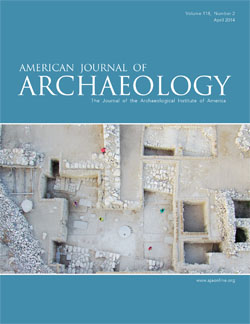AJA Open Access
BY-NCApril 2014 (118.2)
Book Review
Earth Resistance for Archaeologists
By Armin Schmidt
Reviewed by Apostolos Sarris
A number of books have appeared in the last few years dealing with the introduction of the basics of geophysical prospection in archaeology (e.g., C. Carr, Handbook on Soil Resistivity Surveying: Interpretation of Data from Earthen Archeological Sites [Evanston, Ill. 1982]; A. Clark, Seeing Beneath the Soil: Prospecting Methods in Archaeology [New York 1996]; L. Conyers and D. Goodman, Ground-Penetrating Radar: An Introduction for Archaeologists [Walnut Creek, Calif. 1997]; C. Gaffney and J. Gater, Revealing the Buried Past: Geophysics for Archaeologists [Stroud 2003]; L. Conyers, Ground-Penetrating Radar for Archaeology [Walnut Creek, Calif. 2004]; A. Aspinall, C. Gaffney, and A. Schmidt, Magnetometry for Archaeologists [Lanham, Md. 2008]). Most of these books are mainly targeting those who have little or no experience in geophysical prospection and want to investigate the particular methods of surveying. Earth Resistance for Archaeologists is the latest addition to this collection of books, created by an author who has extensive experience in archaeological prospection and is a leading figure on the topic.
Schmidt sets the scene in the beginning for what is to follow, giving a short navigation to the remaining chapters of the book. Chapter 1 introduces the fundamental concepts of electricity dealing with Ohm’s law, the definition of earth resistance, and how this is related to archaeology. The chapter also addresses how the electrical resistivity of soils is influenced by the presence of archaeological features and how the obtained signal varies depending on the environmental conditions.
Most of the mathematical formulas related to the physical properties of the electrical currents and potentials are introduced in chapter 2, which attempts to explain in detail the signal registered from various electrode arrays. This chapter, together with the next one, may be more difficult for those unfamiliar with the topics, although the author tries to keep the math at its lowest possible level. Chapter 3 addresses the examination of the variation of the electrical signature and the issue of the apparent resistivity. With little mathematical notions and the extensive use of diagrams, the author is able to provide a detailed image of the theoretical resistivity responses for the different arrays, with varying prospection depths of the targets or electrode spacing. Vertical electrical soundings are introduced in this chapter together with layered earth modeling, which, even if it can model layered archaeological features, such as floors and mosaics, is seldom used in archaeological prospection.
Electrical resistivity imaging (ERI) is addressed further in chapter 4 with the introduction of pseudosections and tomography. The author provides various ways of carrying out ERI measurements even with conventional equipment, and progresses to the two-dimensional and even three-dimensional inversion theory needed to provide a more realistic distribution of soil resistivity with depth. The issues of electrical resistivity tomography (ERT) and the creation of depth slices to represent the horizontal distribution of the soil resistivity with increasing depth are also examined.
Chapter 5 deals with the most practical issues of resistivity surveying, including the way that measurements are carried out, the choice of the electrode configurations based on specific assessment criteria, the optimization of survey procedures, and the factors that are responsible for influencing the earth resistance measurements, such as environmental factors, instrumental problems, and the topographic effects. I believe that this chapter will be the most helpful to archaeologists who need to understand the practicalities of the soil resistance survey.
Post-survey analysis and, in particular, data manipulation and image processing techniques, are analyzed in chapter 6; all the basic processes of dealing with the data are examined thoroughly. These techniques include grid and line equalization, removal of noise, kernel filtering, and interpolation techniques for the production of images and maps. Without entering into complicated notions of signal processing, the author attempts to provide an overview of the preliminary and basic steps to create a soil resistance map from the registered measurements.
The last chapter (ch. 7) is very helpful for readers, as the author presents a few case studies and examples of soil resistance surveys spanning Neolithic/Bronze Age sites to Roman forts. Most of the examples are from the United Kingdom, and one is from Nepal. In each case study, the author analyzes the survey strategy, the quality of the results, the processing of the data, and the interpretation of the soil resistance maps, introducing the reader to the whole process of the soil resistance survey. The final pages of the book deal with the recent improvements in soil resistance surveying and the advances in instrumentation.
In general, Schmidt covers the topic in a consistent way, keeping a balance between theory and practice and making use of limited mathematical concepts. In this way, the book is meant to be as clear as possible for archaeologists (but also for specialists from other disciplines) who may lack sufficient mathematical background but are still eager to gain some knowledge on resistivity prospection. Combining a well-balanced mixture of theory, practical issues, and examples, the book can become a standard reference for undergraduate students and even professionals.
Apostolos Sarris
Laboratory of Geophysical and Satellite Remote Sensing & Archaeo-environment
Foundation for Research & Technology, Hellas
Institute for Mediterranean Studies
741 00 Rethymnon
Greece
asaris@ret.forthnet.gr
